And now... the news in colour
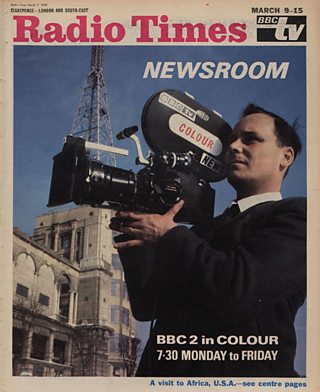
A Radio Times cover reflecting Newsroom's move to colour a few weeks after the event
On 5 February 1968, �������� Two's Newsroom became the first British news programme to be broadcast in colour. A former staff member who worked in the News Stills Library at the time recalls the event.
Launched in April 1964, Newsroom was a 25-minute “survey” of the day’s events. It aimed to put the news in perspective, providing added context and using reporters and specialists as regular contributors. Its home was on �������� Two, which put it at the forefront of Sir David Attenborough’s plans to introduce colour TV to the network in the late 1960s.
Former staff member Roger Wilson worked in the �������� TV's News Stills Library at the time. He recalls the work his team did with Newsroom and the preparations they made for the advent of colour.
Roger Wilson began as a junior clerk in 1964 in the News Information Service at Alexandra Palace, where the ��������'s national television news services were based until late 1969.
His unit was principally a press-cuttings and reference book library. "We got sub-editors coming to us," he says, "wanting background on a particular story. There was no internet in those days and our department had to find facts and check them."
"We worked closely with the staff of the Newsroom. I had the pleasure of working with reporters such as Martin Bell, Tom Mangold, Chris Serpell and Charles Wheeler. You got to learn a lot about them – their likes and dislikes, what would help them most. It was a fun job."
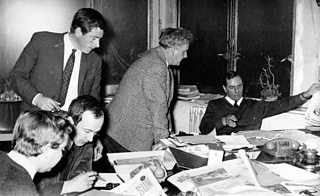
Editorial staff discuss the evening's programme, 1967. Editor Peter Woon is seated on the right, reporter Richard Whitmore stands to the left of the picture.
Then, plans to introduce colour to �������� Two were announced, and the programme began to make preparations. "Peter Woon was the editor of Newsroom at the time and was a great innovator with a sharp mind."
Stills were already used in the programme, from an existing stills library and news agencies: "Facsimile machines (the Muirhead facsimile - MUFAX - is pictured below) allowed black and white news photos to get around the world quickly. It was an ink-jet technology and transmission time was about 20 minutes for a 10"x8" picture."
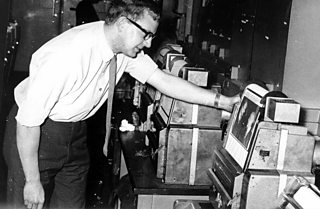
A staff member inspects an image on a news facsimile machine
"In those days," says Wilson, "there was often a delay before film arrived in the newsroom (it might have to be flown across the Atlantic, for example). Stills photos were essential for hot stories because they were the only way of getting immediate images to depict a news story."
Although there was an existing photo library, it was felt that TV news would benefit from having a dedicated repository of colour images on tap, so a new Stills Library was established.
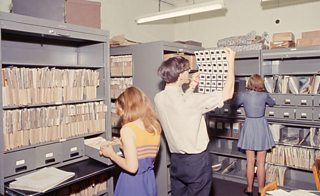
Roger Wilson (centre) inspects a sheet of colour slides
In 1967, the year before colour was introduced to news, Roger Wilson was transferred to the new unit, "so we could be ready when colour was introduced," he says. Wilson and his colleagues focused on building up a stock of colour images. "We went all over the place to get library shots (I even spent a day in a prison with a photographer). A lot of it was about predicting what was wanted."
Radio Times, reflecting on the move to colour a few weeks later, reports that "twelve thousand colour pictures" were replacing the black and white photographs in the stills library.

Supervisor Barry Deamer examines a photo on the colour processing drum.
In addition, there was a stills photo laboratory, which was based on the ground floor of Alexandra Palace. Pictured is a colour processing drum, although the Library would produce both colour and black and white stills for both the �������� Two and �������� One news.

Lab supervisor Barry Deamer using a colour enlarger in the Photo laboratory
"If a photo was to be shown it sometimes had to be prepared two ways - as a transparency for projection or as a 12" print to be placed before a camera."
Because of the way images were projected, there was an inevitable degradation in the quality of the slides as they were used. Whenever possible, it was necessary to make duplicates.

"Captions and photos which were 12x10 inches could be transmitted off special caption scanners but anything else had to go in front of a studio camera," says Roger Wilson.
The arrival of colour was announced by Radio Times that week: "This week heralds another major step forward in the story of Television News. Newsroom goes forward into colour from tonight. And for viewers with colour sets, it will mean the day's events can be seen in a more true-to-life atmosphere."
Not overlooking the work that had been done to prepare, Radio Times also alluded to the technical feat: "For Newsroom staff it means the challenge of more problems to overcome."
For staff themselves, it was the culmination of months of work. "We’d been in preparation for a year then technical and production rehearsals for over a month," says Roger Wilson.
"When colour started there was a sense of relief that we were on air."
Pictures provided courtesy of Roger Wilson
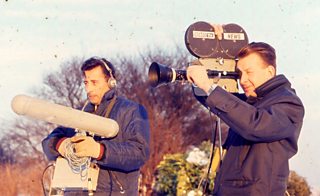
News camera crews recording footage for the Newsroom programme